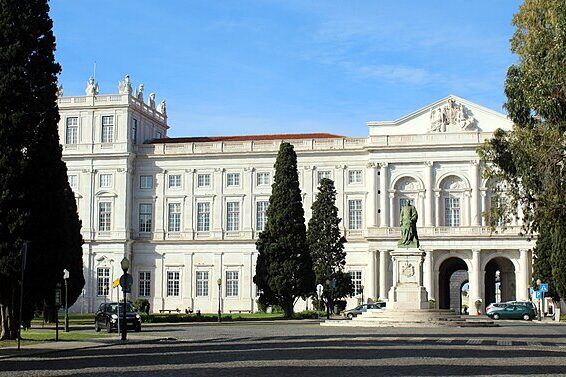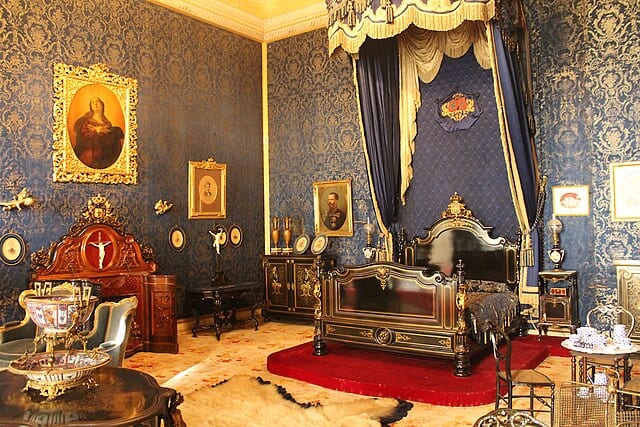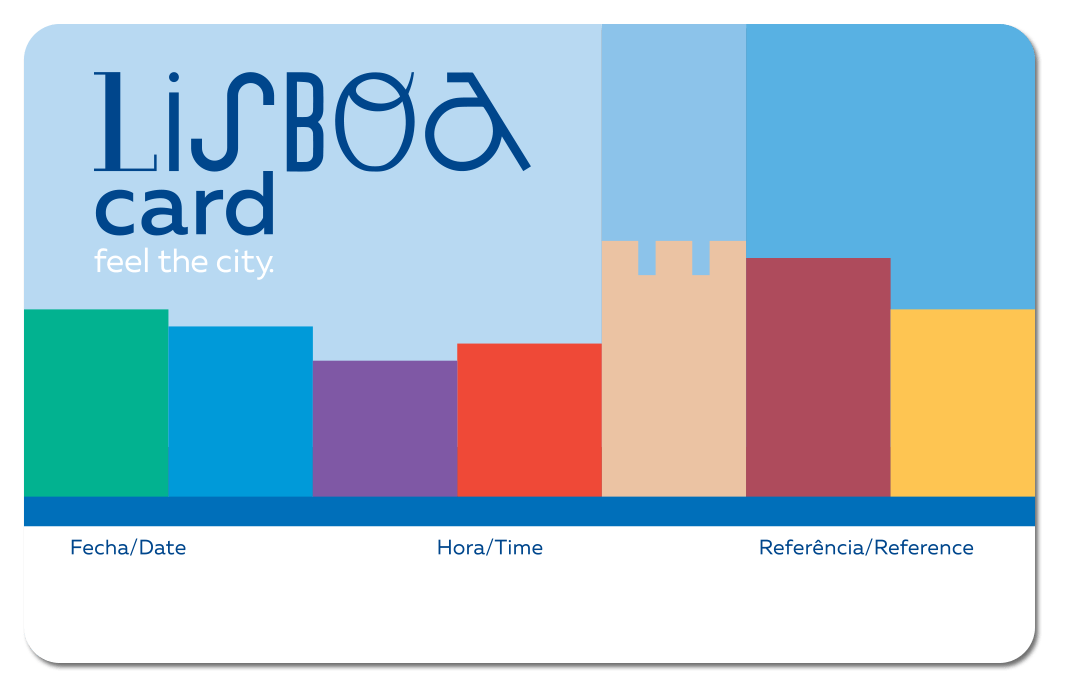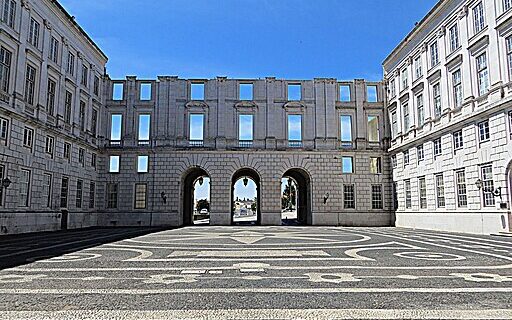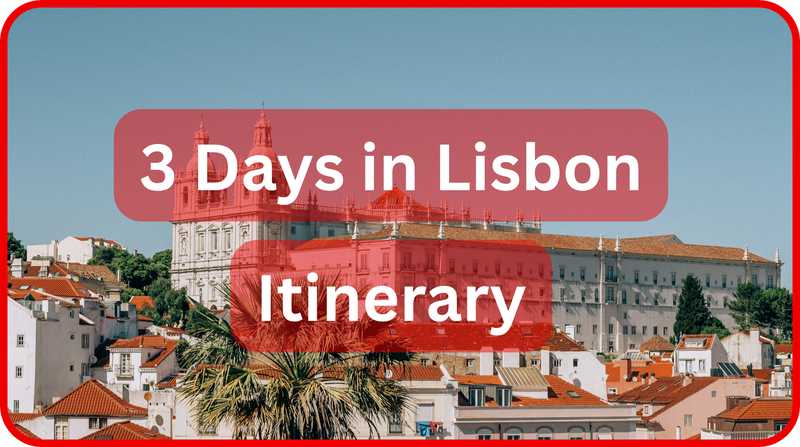Itinerary
Top Attractions
- Sao Jorge Castle
- Jeronimos Monastery
- Belém Tower
- Lisbon Oceanarium
- Sintra Day Trip
- National Palace Ajuda
- Lisbon Zoo
- Queluz National Palace
- Lisbon Cathedral
- Pasteis de Belém
- National Pantheon
- Pilar 7 Bridge Experience
- Benfica Stadium Tour
- Arco da Rua Augusta
- Santa Justa Lift
- Pink Street
- LX Factory
- Carmo Convent
About
Disclaimer
Posts on visit-lisbon.net may contain affiliate links, meaning we get a small commission if you decide to make a purchase through our links, at no cost to you. Any income earned helps maintain this website and keeps it ad-free.
National Palace of Ajuda Lisbon – Tickets and Visitor Guide
How to Visit the National Palace of Ajuda Lisbon Portugal – Location, Tickets & Tips
The National Palace of Ajuda is a historic royal palace in Lisbon with great views over the city and the Tagus river.
Once the official residence of the Portuguese royal family in the 19th century, the palace is now a museum open to the public. Due to its beautiful setting, elegant rooms and rich history, it’s one of the top places to visit in Lisbon, and definitely worth seeing if you’re interested in culture and architecture.
Entry is included for free with the Lisboa Card, which also gives you unlimited access to public transport (buses, trams, metro, and trains to Sintra) and includes entry to 50+ attractions like São Jorge Castle and Jerónimos Monastery. You’ll also get discounts at selected shops and museums.
Prices start from just €31. See all benefits and book your Lisboa Card here.
National Palace of Ajuda – General Information |
|
Location |
Largo da Ajuda, 1349‑021 Lisboa, Portugal |
Opening Times |
Thursday–Tuesday: 10:00 – 18:00 (last admission at 17:30) |
Entry & Tickets |
Regular entry ticket: €15 –
Book National Palace of Ajuda tickets online |
Lisboa Card |
The National Palace of Ajuda is included with the Lisboa Card, along with access to over 50 other top Lisbon attractions and unlimited use of public transport (trams, buses, and metro). |
National Palace of Ajuda Tickets – Prices, Booking & What to Expect |
|
How to Buy Tickets for the National Palace of Ajuda in LisbonThe National Palace of Ajuda is the only royal palace in Lisbon where the 19th-century layout and room decorations are still intact. The palace houses an extensive collection of decorative arts, including silverware, sculptures, furniture, and tapestries. Booking online is recommended, especially on weekends or holidays.
Book your Ajuda Palace tickets online Ajuda National Palace Entry Ticket
Powered by GetYourGuide
|
Visiting National Palace of Ajuda
The Ajuda National Palace is a must-visit landmark to include in your Lisbon itinerary, especially if you’re interested in royal history and architecture. It’s located in the Ajuda district, just west of the city centre.
The palace shares a close historical connection with the Royal Treasury Museum, which is housed in a modern wing right next door. Visiting both on the same day gives you a more complete picture of Portugal’s royal past—from grand halls and furnished rooms to royal jewellery and ceremonial crowns. You can buy a combined ticket, which offers a small discount and saves you the effort of returning another day.
In terms of accessibility, most of the palace is easy to explore. There’s lift access available for visitors with reduced mobility who can’t use the main staircases between floors.
There are no café or restaurant facilities inside the palace, but you’ll find several options nearby in the Ajuda area. Public toilets are available near the entrance.
The visit is self-paced, and there are plenty of information panels throughout, in both Portuguese and English. You should allow around 1 to 1.5 hours to explore the palace, or up to 2.5 hours if you’re also visiting the Royal Treasury Museum.
Tip – When to Visit the National Palace of Ajuda? |
|
Weekday mornings are usually the quietest time to visit, and also gives you more time to explore nearby attractions like the Royal Treasury Museum or the Botanical Garden of Ajuda. The palace is also a great indoor option on rainy days as it’s less crowded than other major landmarks and offers a calm and detailed look at Portugal’s royal history. |
What to see at Ajuda Palace
The Ajuda Palace has a great mix of rooms, each offering insights into how royal life was in Portugal in the 19th century. If you have the time, it’s worth exploring as much of the palace as you can. But if you’re short on time, here are a few highlights you definitely shouldn’t miss:
Audience Room
This room was used for formal meetings and official events. It’s nicely decorated with big mirrors, detailed woodwork and elegant furniture that shows off the palace’s royal style.
Throne Room
Probably the most impressive room in the palace. This is where the king would receive important guests. The space is large and beautifully decorated, with chandeliers and a big red canopy over the throne.
Banquet Room
This is where the royal family held dinners and celebrations, featuring a long table set with fine porcelain and silver.
King Joao IV Room
Named after one of Portugal’s most important kings, this room feels a bit more personal than the others. It’s filled with portraits and furniture and gives insights into the royal family’s daily life.
Chapel
The palace chapel is one of the most peaceful spaces in the whole complex. It’s a quiet room with soft lighting and detailed decorations. What really stands out is the large painting of The Face of Christ by El Greco. It’s powerful and moving, and definitely worth taking a moment to stop and look. This is one of our favourite rooms in the palace.
History of Ajuda National Palace Lisbon
The Ajuda Palace, known as Palácio Nacional da Ajuda in Portuguese, was initially constructed just after the devastating 1755 Lisbon earthquake, which left the royal family in need of a new residence as the Ribeira Palace was severely damaged.
The initial project commenced in 1795 under the direction of architect Manuel Caetano de Sousa. However, the construction was interrupted due to the financial burden of the French invasions during the Peninsular War and the relocation of the royal family to Brazil amidst the Napoleonic Wars.
When the Royal Family returned to Portugal in 1821, a new plan for the palace was developed, reflecting a more modern architectural style. Again, progress continued to be slow due to political instability and lack of funding.
The Ajuda palace was finally completed in 1861, and King Luís moved in, making it the official royal residence. It was truly fit for a king, with luxurious ballrooms, beautiful artworks, and a large library.
Due to issues with the Portuguese Republic in 1910 the palace stopped being used as a royal residence. After a period of neglect, it was restored in the 1930s and later opened to the public as a museum.
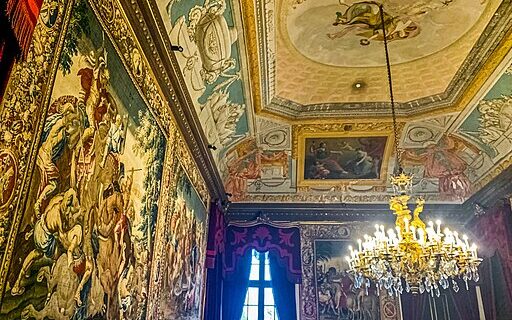
National Palace of Ajuda Location and How to get There
The National Palace of Ajuda is located in the Ajuda district of Lisbon, making it easy to visit alongside many of Lisbon’s top attractions.
It is right next door to the Royal Treasury Museum, and only about a 20 minute walk from Jeronimos Monastery.
You can reach the palace using various forms of Lisbon public transport. The easiest option is the tram. The closest tram stop is Ajuda (with the 18E trams stopping there), which is just a 5 minute walk from the palace entrance.
Several Carris buses also stop nearby. You can take lines 729, 732, or 742 and get off at Ajuda, which is around a 4-minute walk away.
If you are coming by metro, please note there’s no Metro station right next to the Ajuda palace, but you can take the blue line (Linha Azul) to Belém or Alcântara-Terra and then use the bus or tram for the final bit.
Ajuda National Palace: Frequently Asked Questions
Is the National Palace of Ajuda worth visiting?
Yes, National Palace of Ajuda is an unique place in Lisbon and is definitely worth visiting, especially if you’re interested in Portuguese history, royal life, or architecture. The rooms are beautifully preserved and decorated with original furniture and artworks. It’s also less crowded than other attractions in Lisbon, which makes for a more relaxed visit.
Can I visit the National Palace of Ajuda and the Royal Treasury Museum on the same day?
Yes, the Royal Treasury Museum is right next to the National Palace of Ajuda, within the same complex, and a combined ticket is available. Most people spend around 2.5 hours if visiting both, so it fits easily into a morning or afternoon.
More on Visit-Lisbon

